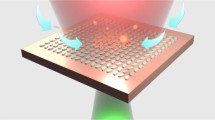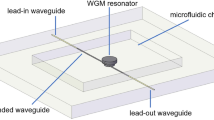Abstract
A liquid microdroplet could be a naturally simple, miniaturized and effective optical cavity by itself due to the intriguing optofluidic properties associated with its surface tension-induced spherical shape. It had been shown that optical whispering gallery modes (WGMs) can be present along the circular rim in the equatorial plane of a sessile microdroplet, and this phenomenon had been leveraged for biosensing demonstrations. However, optical coupling to such equatorial modes for their excitation and monitoring is mostly based on either tapered fiber coupling or free-space beam coupling, each of which demandingly requires precise alignment of the tapered fiber or the free-space beam adjacent to the equatorial surface of the resonator. In this paper, we show that WGMs could also be stimulated along the meridian plane of a liquid microdroplet resting on a properly designed nanostructured chip surface. The geometrical morphology and optical characteristics of a microdroplet cavity are critical to achieve a high-quality Q factor and therefore to realize high-resolution in situ and in vivo monitoring of trace analytes. The unavoidable deformation along the meridian rim of the sessile microdroplet can be controlled and regulated by tailoring the nanopillar structures and their associated hydrophobicity. The nanostructured superhydrophobic chip surface and its impact on the microdroplet morphology are modeled by Surface Evolver, which is subsequently validated by the Cassie–Wenzel theory of wetting. The influence of the microdroplet morphology on the optical characteristics of WGMs is further numerically studied using the finite-difference time-domain method and it is found that meridian WGMs with intrinsic quality factor Q exceeding 104 can exist. Importantly, such meridian WGMs can be efficiently excited by a waveguiding structure embedded in the planar chip, which could significantly reduce the overall system complexity by eliminating conventional mechanical coupling parts. Our simulation results also demonstrate that this optofluidic resonator can achieve a sensitivity as high as 530 nm/RIU. This on-chip coupling scheme could pave the way for developing lab-on-a-chip resonators for high-resolution sensing of trace analytes in various applications ranging from chemical detections, biological reaction processes to environmental protection.











Similar content being viewed by others
References
An L, Zheng Z, Li Z, Zhou T, Cheng J (2009) Ultra-wideband single-polarization single-mode, high nonlinearity photonic crystal fiber. Opt Commun 282:3266–3269
Anand S et al (2016) Observation of whispering gallery modes in elastic light scattering from microdroplets optically trapped in a microfluidic channel. JOSA B 33:1349–1354
Ashkin A, Dziedzic J (1977) Observation of resonances in the radiation pressure on dielectric spheres. Phys Rev Lett 38:1351
Avino S et al (2014) Direct sensing in liquids using whispering-gallery-mode droplet resonators. Adv Opt Mater 2:1155–1159
Baaske M, Vollmer F (2012) Optical resonator biosensors: molecular diagnostic and nanoparticle detection on an integrated platform. ChemPhysChem 13:427–436
Banerjee S (2008) Simple derivation of Young, Wenzel and Cassie–Baxter equations and its interpretations. arXiv:0808.1460
Bar-David D, Maayani S, Martin LL, Carmon T (2018) Cavity optofluidics: a μdroplet’s whispering-gallery mode makes a μvortex. Opt Express 26:19115–19122
Bartolo D et al (2006) Bouncing or sticky droplets: impalement transitions on micropatterned surfaces. Europhys Lett 74(2):299–305
Brakke KA (1992) The surface evolver. Exp Math 1:141–165
Cassie A, Baxter S (1944) Wettability of porous surfaces. Trans Faraday Soc 40:546–551
Cheng J-T, Chen C-L (2010a) Active thermal management of on-chip hot spots using EWOD-driven droplet microfluidics. Exp Fluids 49:1349–1357
Cheng J-T, Chen C-L (2010b) Adaptive chip cooling using electrowetting on coplanar control electrodes. Nanoscale Microscale Thermophys Eng 14:63–74
Cheng J-T, Vandadi A, Chen C-L (2012) Condensation heat transfer on two-tier superhydrophobic surfaces. Appl Phys Lett 101:131909
Dahan R, Martin LL, Carmon T (2016) Droplet optomechanics. Optica 3:175–178
De Gennes P-G (1985) Wetting: statics and dynamics. Rev Mod Phys 57:827
Deng T et al (2009) Nonwetting of impinging droplets on textured surfaces. Appl Phys Lett 94:133109
Extrand CW (2002) Model for contact angles and hysteresis on rough and ultraphobic surfaces. Langmuir 18:7991–7999
Fabbri P et al (2006) Surface properties of fluorinated hybrid coatings. J Appl Polym Sci 102:1483–1488
Giorgini A, Avino S, Malara P, De Natale P, Gagliardi G (2017) Fundamental limits in high-Q droplet microresonators. Sci Rep 7:41997
Gregor M et al (2010) An alignment-free fiber-coupled microsphere resonator for gas sensing applications. Appl Phys Lett 96:231102
Grover R et al (2003) Laterally coupled InP-based single-mode microracetrack notch filter. IEEE Photonics Technol Lett 15:1082–1084
He L, Özdemir ŞK, Zhu J, Kim W, Yang L (2011) Detecting single viruses and nanoparticles using whispering gallery microlasers. Nat Nanotechnol 6:428
Ishimoto Y, Morishita Y (2014) Bubbly vertex dynamics: a dynamical and geometrical model for epithelial tissues with curved cell shapes. Phys Rev E 90:052711
Jampani VSR, Humar M, Muševič I (2013) Resonant transport of light from planar polymer waveguide into liquid-crystal microcavity. Opt Express 21:20506–20516
Jeong CY, Kim M, Kim S (2014) Metal nanodisk hybrid plasmonic resonator on dielectric substrate for relieved fabrication complexity. Opt Express 22:5772–5780
Jonáš A, Karadag Y, Mestre M, Kiraz A (2012) Probing of ultrahigh optical Q-factors of individual liquid microdroplets on superhydrophobic surfaces using tapered optical fiber waveguides. JOSA B 29:3240–3247
Jung YC, Bhushan B (2007) Wetting transition of water droplets on superhydrophobic patterned surfaces. Scripta Mater 57:1057–1060
Jung YC, Bhushan B (2008) Dynamic effects of bouncing water droplets on superhydrophobic surfaces. Langmuir 24:6262–6269
Kashaninejad N, Chan WK, Nguyen N-T (2012) Eccentricity effect of micropatterned surface on contact angle. Langmuir 28:4793–4799
Kashaninejad N, Nguyen N-T, Chan WK (2013) The three-phase contact line shape and eccentricity effect of anisotropic wetting on hydrophobic surfaces. Soft Matter 9:527–535
Kiraz A et al (2007a) Large spectral tuning of liquid microdroplets standing on a superhydrophobic surface using optical scattering force. Appl Phys Lett 91:231102
Kiraz A et al (2007b) Single glycerol/water microdroplets standing on a superhydrophobic surface: optical microcavities promising original applications. J Nanophotonics 1:011655
Kusumaatmaja H, Blow M, Dupuis A, Yeomans J (2008) The collapse transition on superhydrophobic surfaces. EPL 81:36003
Lin H-B, Eversole JD, Campillo AJ (1992) Spectral properties of lasing microdroplets. JOSA B 9:43–50
Ma M, Hill RM (2006) Superhydrophobic surfaces. Curr Opin Colloid Interface Sci 11:193–202
Machavariani G, Davidson N, Ishaaya A, Friesem A, Hasman E (2002) Efficient formation of a high-quality beam from a pure high-order Hermite–Gaussian mode. Opt Lett 27:1501–1503
Newton M, Herbertson D, Elliott S, Shirtcliffe N, McHale G (2006) Electrowetting of liquid marbles. J Phys D Appl Phys 40:20
Nishino T, Meguro M, Nakamae K, Matsushita M, Ueda Y (1999) The lowest surface free energy based on –CF3 alignment. Langmuir 15:4321–4323
Reyssat M, Pépin A, Marty F, Chen Y, Quéré D (2006) Bouncing transitions on microtextured materials. EPL 74:306
Reyssat M, Yeomans J, Quéré D (2007) Impalement of fakir drops. EPL 81:26006
Righini G et al (2011) Whispering gallery mode microresonators: fundamentals and applications. Rivista del nuovo cimento 34:435–488
Scullion M, Di Falco A, Krauss T (2011) Slotted photonic crystal cavities with integrated microfluidics for biosensing applications. Biosens Bioelectron 27:101–105
Shin DH, Lee SH, Jung J-Y, Yoo JY (2009) Evaporating characteristics of sessile droplet on hydrophobic and hydrophilic surfaces. Microelectron Eng 86:1350–1353
Soria S et al (2011) Optical microspherical resonators for biomedical sensing. Sensors 11:785–805
Sun Y et al (2013) The un-symmetric hybridization of graphene surface plasmons incorporating graphene sheets and nano-ribbons. Appl Phys Lett 103:241116
Sun Y, Zheng Z, Cheng J, Liu J (2014) Graphene surface plasmon waveguides incorporating high-index dielectric ridges for single mode transmission. Opt Commun 328:124–128
Tanyeri M, Kennedy IM (2008) Detecting single bacterial cells through optical resonances in microdroplets. Sens Lett 6:326–329
Tanyeri M, Perron R, Kennedy IM (2007) Lasing droplets in a microfabricated channel. Opt Lett 32:2529–2531
Tian Y, Su B, Jiang L (2014) Interfacial material system exhibiting superwettability. Adv Mater 26:6872–6897
Tzeng H-M, Wall KF, Long M, Chang R (1984) Laser emission from individual droplets at wavelengths corresponding to morphology-dependent resonances. Opt Lett 9:499–501
Vollmer F et al (2002) Protein detection by optical shift of a resonant microcavity. Appl Phys Lett 80:4057–4059
Wan Y et al (2017) Resonant mode engineering of photonic crystal sensors clad with ultralow refractive index porous silicon dioxide. Adv Opt Mater 5:1700605
Ward JM et al (2018) Nanoparticle sensing beyond evanescent field interaction with a quasi-droplet microcavity. Optica 5:674–677
Wenzel RN (1936) Resistance of solid surfaces to wetting by water. Ind Eng Chem 28:988–994
Zhang M, Wu G (2017) High quality factor multi-layer symmetric hybrid plasmonic microresonator for sensing applications. Opt Commun 403:68–72
Zhao L, Cheng J-T (2018) The mechanism and universal scaling law of the contact line friction for the Cassie-state droplets on nanostructured ultrahydrophobic surfaces. Nanoscale 10:6426–6436
Zheng L, Zhi M, Chan Y, Khan SA (2018) Embedding liquid lasers within or around aqueous microfluidic droplets. Lab Chip 18:197–205
Zhi Y, Yu XC, Gong Q, Yang L, Xiao YF (2017) Single nanoparticle detection using optical microcavities. Adv Mater 29:1604920
Zhu H, White IM, Suter JD, Dale PS, Fan X (2007) Analysis of biomolecule detection with optofluidic ring resonator sensors. Opt Express 15:9139–9146
Zhu J et al (2010) On-chip single nanoparticle detection and sizing by mode splitting in an ultrahigh-Q microresonator. Nat Photonics 4:46
Zullo R et al (2016) Laser-frequency locking to a whispering-gallery-mode cavity by spatial interference of scattered light. Opt Lett 41:650–652
Acknowledgements
This work was supported by NSFC 61775008, NSF ECCS 1550749 and NSF ECCS 1808931. The authors also acknowledge the Advanced Research Computing at Virginia Tech (http://www.arc.vt.edu) for providing computational resources and technical support that have contributed to the results reported in this paper.
Author information
Authors and Affiliations
Corresponding authors
Ethics declarations
Conflict of interest
The authors declare no competing financial interest.
Additional information
Publisher's Note
Springer Nature remains neutral with regard to jurisdictional claims in published maps and institutional affiliations.
Electronic supplementary material
Below is the link to the electronic supplementary material.
Rights and permissions
About this article
Cite this article
Zhang, M., Cheng, W., Zheng, Z. et al. Meridian whispering gallery modes sensing in a sessile microdroplet on micro/nanostructured superhydrophobic chip surfaces. Microfluid Nanofluid 23, 106 (2019). https://doi.org/10.1007/s10404-019-2272-4
Received:
Accepted:
Published:
DOI: https://doi.org/10.1007/s10404-019-2272-4




